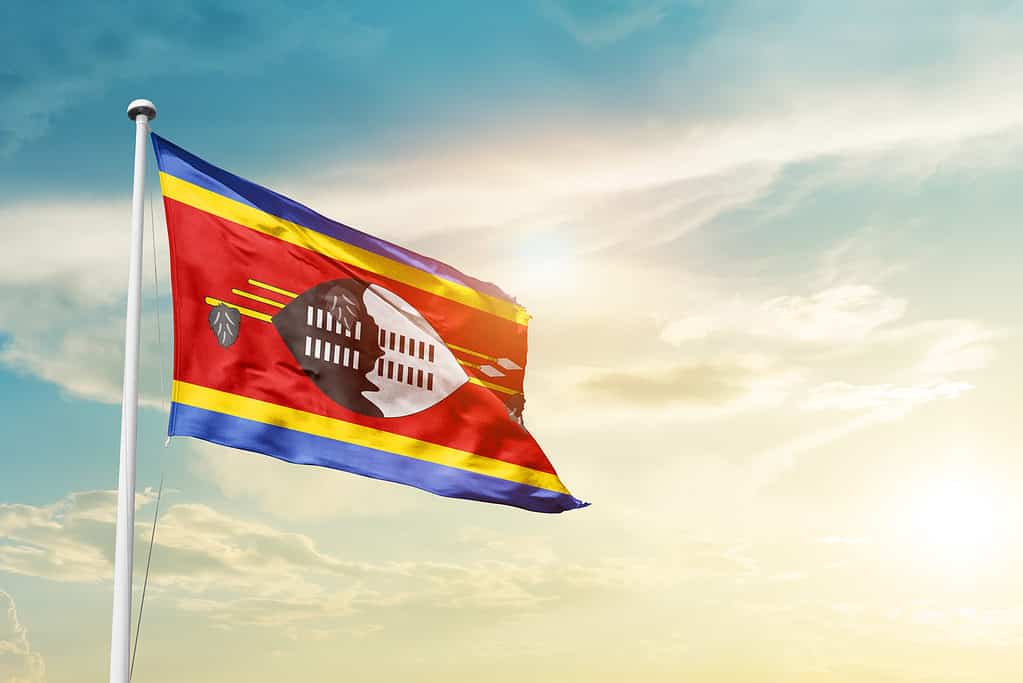The name eSwatini is occasionally used in English to refer to the landlocked country of Eswatini, which is also known as the Kingdom of Eswatini. Swaziland is still a common name for it, as this was a recent change that took place in 2018. In fact, foreign countries and fellow people were shocked when the king of Swaziland recently announced that the country’s official name would return to eSwatini, which it used before British dominance. King Mswati III, one of the few remaining absolute monarchs in the world, announced the decision to alter the name at celebrations marking the 50th anniversary of the country’s declaration of independence from Britain.
Although Eswatini is one of the smallest countries in Africa, it has a rich historical background. After gaining independence from the British Empire, Eswatini (formerly Swaziland) adopted its own flag on October 6, 1968, to represent its freedom. Keep reading to learn more about the history, meaning, and symbolism of the flag of Eswatini!
Flag of Eswatini (Swaziland) History

The flag of Eswatini’s design is based on a military flag presented to pioneer forces in 1941 by King Seboza II.
©em_concepts/Shutterstock.com
April 25, 1967, was the inaugural raising of the current flag of Eswatini. After gaining independence from the British Empire a month prior, Eswatini (formerly Swaziland) officially adopted its current flag on October 6, 1968. The design of the flag is based on the military flag which King Seboza II gave to the pioneer forces in 1941.
The Backstory
In order to assist the Allied forces with the invasion of Italy, the Swazi Pioneer Corps was being trained at the time. King Sobhuza II tasked three princesses with creating a special flag for the military. On a background of blue, yellow, and red horizontal bars, the image consists of a shield in black and white with a staff and two spears. The flag was presented to them as a reminder of the country’s military customs.
In order to identify structures, a political network for organizing public gatherings was developed in 1954. Its flag was based on the one flown by the Swazi Pioneer Corps. The Swazi National Council decided to use that as the new national flag. It was hoisted for the very first time in place of the Union Jack on April 25, 1967. Minor creative adjustments were made on October 30, 1967, but on September 6, 1968—Independence Day—nothing changed.
Flag of Eswatini (Swaziland) Meaning
Design:
King Sobhuza II’s design features a black and white shield with two spears and a staff against a backdrop of five horizontal bars with an uneven thickness in the following ratios: 3: 1: 8: 1: 3. A staff with injobo tassels (bunches of feathers) from the widowbird and lourie bird are hanging from it and supporting the shield.
Eswatini is home to a species of bird known as the widowbird, which has stunning, long tail feathers. Only members of the Swaziland royalty are permitted to wear the red lourie (turaco) feathers. These feathers serve as a symbol of their ancestry. To mirror the natural color of the widowbird, the tassels’ color was altered to black in 2011.
Colors:
The following colors make up the official Eswatini flag: blue, red, yellow, black, and white. its primary colors are blue, red, and yellow, with black and white as accent colors of the fighting shield placed in the center. Two blue stripes are at the top and bottom. A red stripe in the middle has two slender yellow stripes around it. This makes up the flag’s five horizontal stripes. A black and white ox-hide fighting shield from the historic Swazi Emasotsha Regiment is put horizontally on the red stripe.
Flag of Eswatini (Swaziland) Symbolism

The flag of Eswatini represents peace, past wars, and natural resources. along with protection from adversaries.
©Hybrid Gfx/Shutterstock.com
Two spears and a shield from the Nguni tribe serve as the flag’s primary symbols. They represent protection from the nation’s adversaries. The black-and-white color scheme of this symbol illustrates how blacks and whites cohabit in Swaziland. The remaining three colors also each have a distinct meaning.
Natural resources are represented by yellow; peace and stability are represented by blue, and past wars are represented by red. An ox shield from the traditional Swazi Emasotosha is in the center of the flag. The Emasotsha Regiment used this particular shield throughout the 1920s. It is adorned and reinforced by feathers. The Eswatini royal dynasty is represented by these feather tufts.
Up Next:
- The Flag of Zimbabwe: History, Meaning, and Symbolism
- The Flag of Australia: History, Meaning, and Symbolism
- The Flag of The Netherlands: History, Meaning, and Symbolism
The photo featured at the top of this post is © M_Videous/Shutterstock.com
Sources
- Flags of the World, Available here: https://www.fotw.info/flags/sz.html
- Wikiwand, Available here: https://www.wikiwand.com/en/Flag_of_Eswatini
- Flag Color Codes, Available here: https://www.flagcolorcodes.com/swaziland-eswatini
Thank you for reading! Have some feedback for us? Contact the AZ Animals editorial team.






